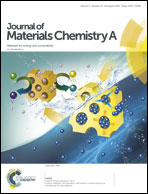All-ceramic asymmetric membranes with superior hydrogen permeation†
Abstract
BaCe0.65Zr0.20Y0.15O3−δ–Gd0.2Ce0.8O2−δ (BCZY–GDC) composite with a planar asymmetrical architecture was investigated for the first time as a hydrogen separation membrane in the 600 °C to 750 °C temperature range. Asymmetrical membranes comprising a 20 μm thick dense BCZY–GDC layer supported on a 600 μm thick porous substrate with the same composition were successfully produced through a tape casting process. The influence of the dense layer composition on hydrogen separation and the catalytic activation of the dense membrane layer and porous support were thoroughly studied. The hydrogen permeation process was further characterized by varying the environment humidification degree and temperature and by shifting the sweep and feed gas compositions. This work highlights the importance of preserving the dual proton (BCZY) and electron (GDC) conductor phases during the sintering step of the membrane to enhance H2 permeation; a value of 0.47 mL min−1 cm−2 at 750 °C was obtained, which is currently one of the highest H2 fluxes obtained for all-ceramic proton-conducting membranes. In addition, a strong improvement is achieved when the feed/sweep sides of the membrane are reversed, i.e. H2 feeding in the support side leads to a flux increase up to 0.68 mL min−1 cm−2 at 750 °C when only the sweep side is hydrated. These results demonstrate that these asymmetric dual phase BCZY–GDC membranes are the most promising candidates for H2 separation applications at high temperatures.



 Please wait while we load your content...
Please wait while we load your content...